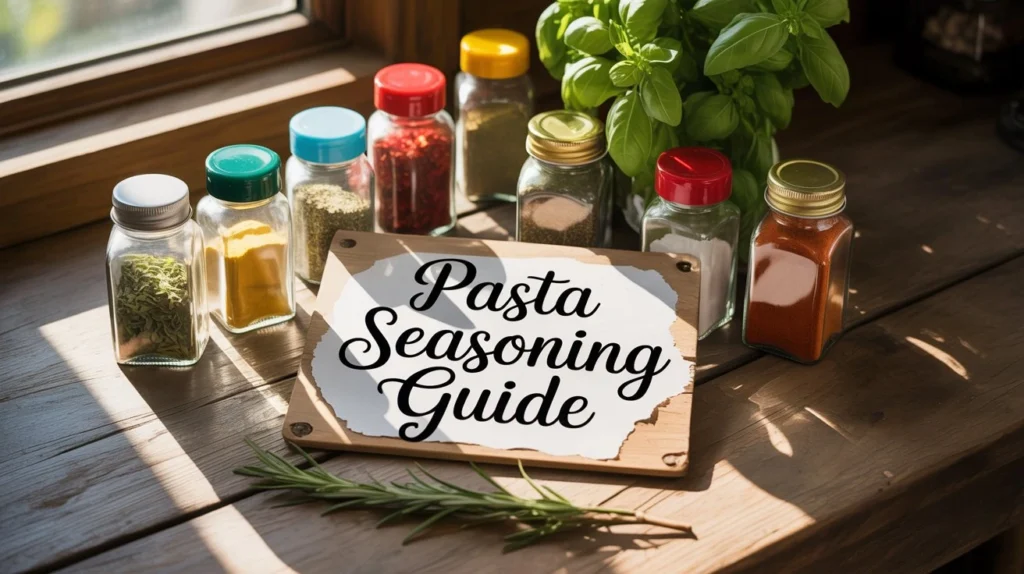
Pasta doesn’t just shine because of the sauce—it’s the Pasta Seasoning that makes the real difference. Even fresh noodles and rich sauce can feel flat without it, while a simple garlic and olive oil pasta can taste amazing when seasoned well.
After years of experimenting in my kitchen, I’ve learned that seasoning pasta is about building layers of flavor. Each element—herbs, spices, or a dash of lemon—adds balance and depth to the dish.
In this guide, we’ll explore what pasta seasoning really means, the best types to use, how to combine them, and even how to create your own blends. I’ll also share tips, mistakes to avoid, and personal insights to help you season pasta with confidence.
So, let’s begin with the basics.
What Does Pasta Seasoning Actually Mean?
When people hear the term “pasta seasoning,” they often think of one single spice mix. But in reality, pasta seasoning refers to a collection of herbs, spices, salts, and even acidic or spicy ingredients that come together to bring life to pasta dishes.
Think of plain boiled pasta—it doesn’t taste like much on its own. But the moment you toss it with olive oil, garlic, basil, and black pepper, it suddenly becomes fragrant, vibrant, and satisfying. That’s the power of seasoning.
The art lies in choosing which seasonings work best for the type of pasta you’re making. A creamy Alfredo calls for nutmeg and thyme, while a spicy arrabbiata needs red pepper flakes. Understanding these pairings is the first step to mastering pasta.
Now that we’ve understood the meaning, let’s move on to the different types of seasonings that can elevate your pasta.
Types of Pasta Seasonings and How They Work
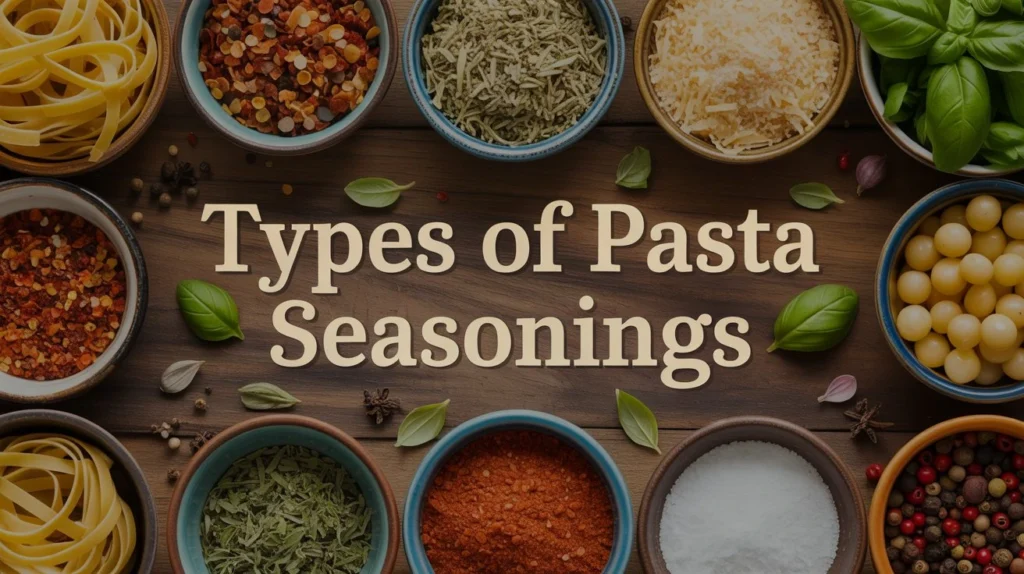
To keep things simple, I like dividing pasta seasonings into groups. This way, it’s easier to know when and how to use them.
1. Fresh and Dried Herbs
Herbs are the backbone of pasta flavor. They bring freshness, aroma, and sometimes even sweetness.
- Basil: The most iconic pasta herb. Fresh basil is perfect for pesto or to sprinkle at the end of cooking. Dried basil, on the other hand, blends well into sauces during simmering.
- Oregano: Strong, earthy, and slightly bitter, oregano is excellent for tomato-based sauces. If I’m making marinara, oregano is non-negotiable.
- Parsley: Light and fresh, parsley works as both a garnish and a flavor enhancer. It balances out rich, creamy sauces.
- Thyme: Earthy and warm. I often use thyme in baked pasta or when making Alfredo—it holds up well during long cooking.
- Rosemary & Sage: These herbs are stronger, so a little goes a long way. Rosemary pairs well with roasted vegetables, while sage shines in butter-based sauces.
Pro Tip: Fresh herbs are best added at the end, while dried herbs should go in earlier so they can release their full aroma.
2. Essential Spices
Spices bring warmth, depth, and sometimes a little heat.
- Garlic: An absolute classic. Fresh garlic sautéed in olive oil forms the base of countless pasta sauces. Roasted garlic adds sweetness, while garlic powder is useful for quick blends.
- Black Pepper: Freshly cracked black pepper sharpens the flavor of almost any pasta. It’s especially key in simple dishes like Cacio e Pepe.
- Red Pepper Flakes: Just a pinch can take your pasta from mild to exciting. I love sprinkling them into aglio e olio for that perfect spicy kick.
- Nutmeg: This one surprises many people, but a tiny pinch in creamy sauces makes them taste richer and more comforting.
- Paprika: Sweet or smoked paprika can add color and a subtle depth. Smoked paprika, in particular, is amazing if you want a slightly smoky twist.
3. Salt and Salty Additions
Salt isn’t just a seasoning—it’s a flavor enhancer.
- Salt in pasta water: Always add enough salt to your boiling pasta water. Pasta should absorb flavor from the start.
- Anchovies: When cooked into sauce, they melt away, leaving behind a deep umami richness.
- Capers and Olives: Great for Mediterranean-style pastas, adding bursts of briny flavor.
- Cheese (Parmesan, Pecorino): Not only adds saltiness but also creaminess. A final sprinkle of cheese at the table always takes pasta up a notch.
4. Acidic Seasonings
Acid cuts through richness and balances heavy flavors.
- Lemon Juice/Zest: Brightens seafood and vegetable pastas. Personally, I always keep a lemon nearby while cooking pasta—it saves dishes from tasting flat.
- Vinegar: A splash of balsamic can add sweetness and tang to tomato sauces.
- Tomatoes: Whether fresh or canned, they naturally bring acidity into the dish.
5. Heat and Spicy Flavors
If you enjoy a little adventure, heat is your friend.
- Cayenne Pepper: Adds gentle heat without overpowering.
- Hot Sauce: A few drops can make creamy pastas more exciting.
- Fresh Chilies: When sautéed in oil, they release a sharp, fresh spiciness.
6. Creative Condiments
Sometimes unexpected ingredients make pasta unforgettable.
- Mustard: A spoon of Dijon mustard in creamy sauces adds tang and depth.
- Ketchup: While controversial, some people use it for quick tomato-based pasta.
- Pesto: Not just a sauce—it can also be mixed into mayo, oil, or butter as a seasoning base.
If you’d like to explore more ideas, I’m linking a Quora discussion: What seasonings and spices can go on pasta?. It’s a useful resource packed with tips and suggestions to make your pasta dishes more flavorful and exciting.
Making Your Own Pasta Seasoning Blend
Now that we’ve gone through all the categories, let’s talk about making your own blend. A homemade pasta seasoning mix is handy when you want quick flavor without measuring every herb individually.
I’ll give you 4 easy-to-make pasta seasoning mixes, and for each, I’ll also mention which type of pasta dish they go best with. All blends will use simple ingredients you can easily store.
1. Classic Italian Pasta Seasoning
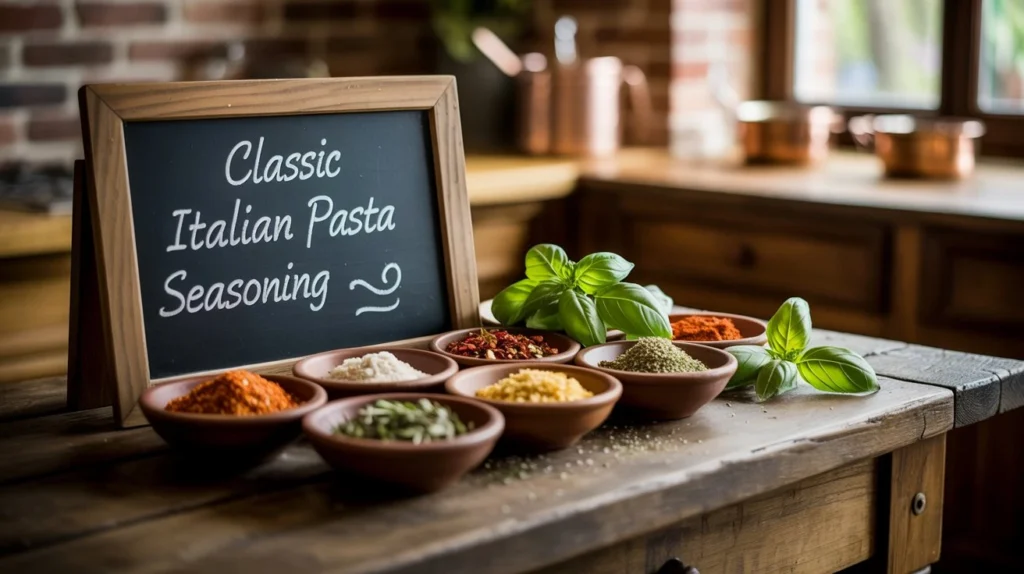
This one works beautifully with marinara, arrabbiata, or any tomato-based pasta dish. The balance of oregano and basil enhances tomato flavors naturally.
Ingredients:
- 1 tbsp dried oregano
- 1 tbsp dried basil
- 1 tsp garlic powder
- 1 tsp onion powder
- ½ tsp crushed red chili flakes
- ½ tsp black pepper
Steps:
- Mix all ingredients in a small bowl.
- Store in an airtight jar.
- Use 1–2 tsp per serving of tomato pasta sauce for that authentic Italian kick.
2. Garlic Lover’s Pasta Seasoning (Best for Creamy & Alfredo Pasta)
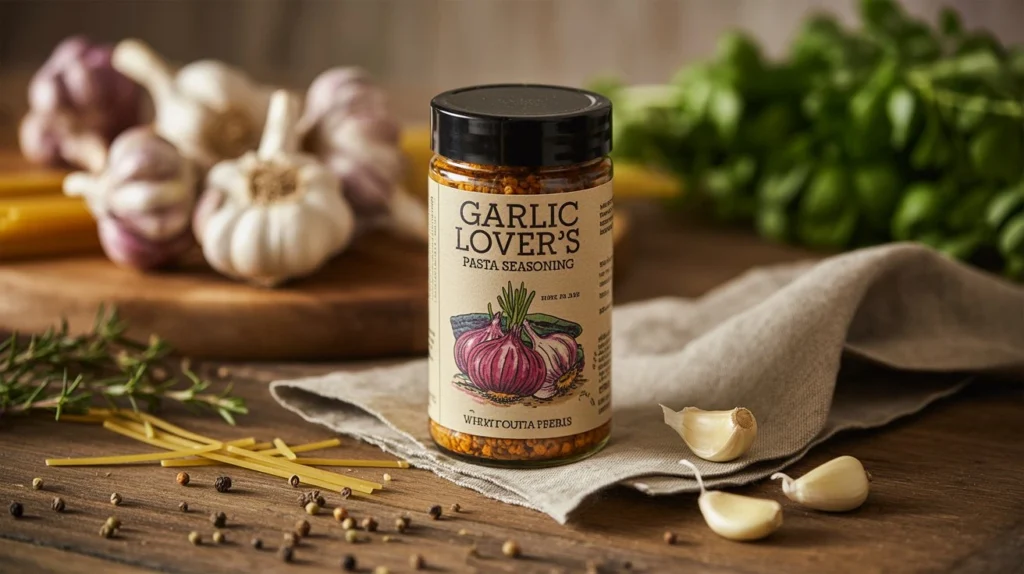
If you enjoy white sauces, Alfredo, or cheesy creamy pasta, this blend adds depth with garlic and parsley.
Ingredients:
- 1 tbsp garlic powder
- 1 tbsp dried parsley
- 1 tsp onion powder
- 1 tsp dried thyme
- ½ tsp ground black pepper
- ½ tsp nutmeg (optional, but amazing in creamy sauces)
Steps:
- Mix all spices in a jar.
- Store in a cool, dry place.
- Add 1 tsp while cooking cream sauces or sprinkle on top before serving.
3. Spicy Kick Pasta Seasoning (Best for Penne Arrabbiata or Spicy Lovers)
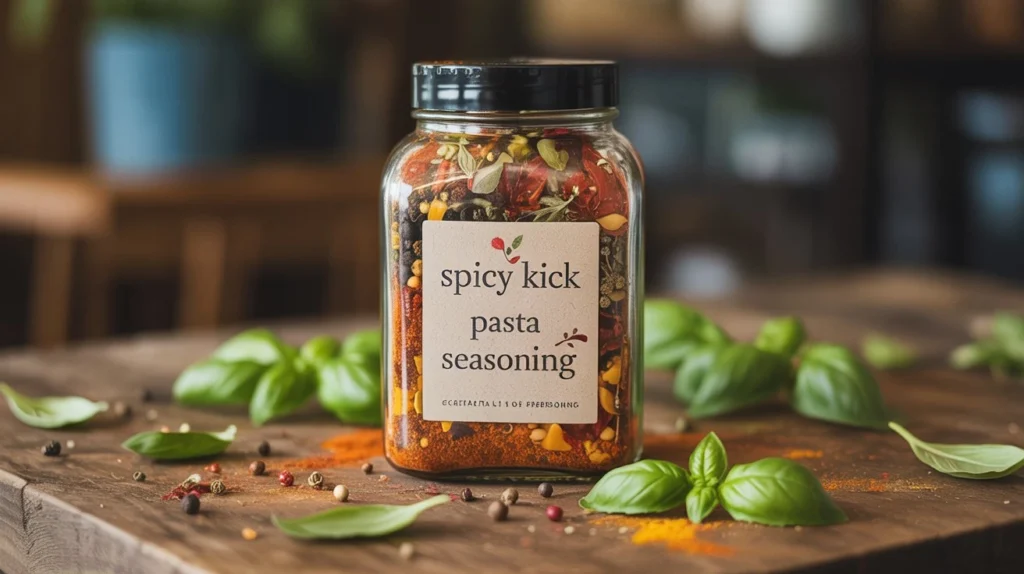
Perfect for those who love pasta with a fiery touch. Works best with penne, spaghetti, or even baked pasta.
Ingredients:
- 1 tbsp dried chili flakes
- 1 tbsp smoked paprika
- 1 tsp dried oregano
- 1 tsp dried basil
- ½ tsp black pepper
- ½ tsp garlic powder
Steps:
- Mix and store in a glass jar.
- Add ½ tsp for mild spice or 1 tsp+ for extra hot flavor.
- Works best when sautéed in olive oil before adding pasta or sauce.
4. Mediterranean Herb Pasta Seasoning (Best for Olive Oil & Light Pastas)
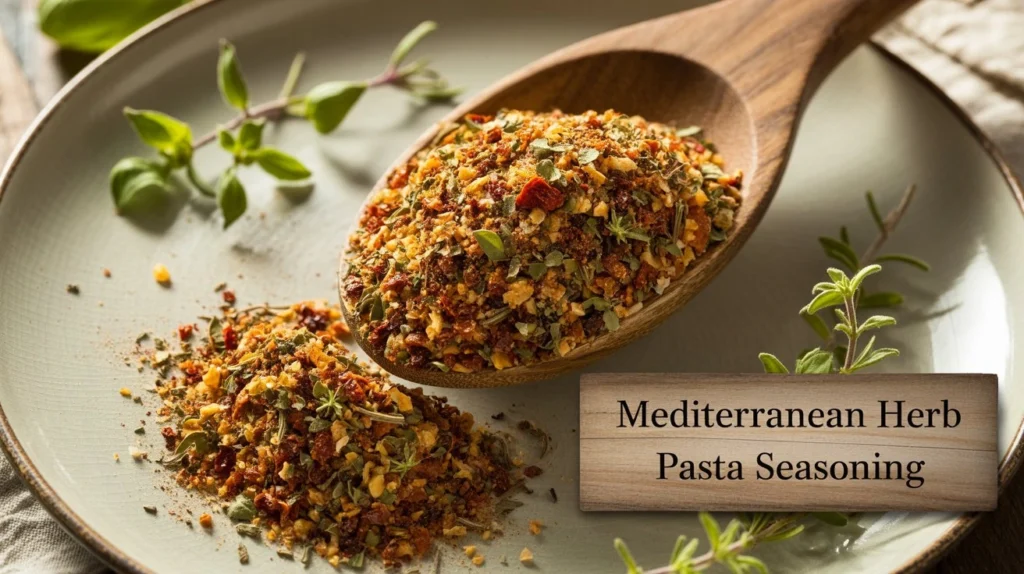
This blend is lighter and fragrant, perfect for Aglio e Olio, pesto pasta, or lemon-butter pasta.
Ingredients:
- 1 tbsp dried thyme
- 1 tbsp dried rosemary (crushed)
- 1 tsp dried parsley
- 1 tsp lemon zest (dried if storing)
- ½ tsp oregano
- Pinch of sea salt
Steps:
- Mix herbs and zest together.
- Store in an airtight container.
- Toss cooked pasta with olive oil and 1 tsp of this seasoning for a fresh Mediterranean taste.
Pro Tip from my own cooking experience:
Make small jars of each blend, label them (Classic, Creamy, Spicy, Mediterranean), and keep them near your stove. Trust me, when you’re in a rush, just tossing a teaspoon into your sauce saves time and makes it taste like you worked much longer than you actually did.
For more guidance, check out this Reddit thread: Spices for Plain Pasta. Along with a YouTube video, it highlights different spice combinations that can make even the simplest pasta taste amazing.
How and When to Add Seasonings
We’ve discussed what seasonings to use, but the real trick is knowing when to add them.
- At the start: Build your flavor base. Heat olive oil, then add garlic, onions, or chili flakes. This step sets the tone for your dish.
- During cooking: Add dried herbs and spices while simmering sauces so their flavors develop fully.
- At the end: Finish with fresh herbs, lemon zest, or cheese to brighten the dish.
- At the table: Leave salt, pepper, and chili flakes for customization—every guest can adjust according to taste.
Adjusting Pasta Seasonings for Different Dishes
Every pasta dish has its own personality, and the seasoning should match it.
- Marinara: Go heavy on oregano, garlic, and red pepper flakes for boldness.
- Pesto Pasta: Balance with extra lemon juice or Parmesan to keep it fresh.
- Alfredo: A pinch of nutmeg brings warmth and richness.
- Arrabbiata: Double the chili flakes for an authentic fiery kick.
- Pasta Primavera: Mix and match fresh herbs with seasonal vegetables.
My Personal Experience with Seasonings
When I first started cooking pasta, I made the mistake of throwing everything in at once—garlic, herbs, spices, lemon juice—all dumped together. The result was often messy and overwhelming.
Over time, I learned that pasta seasoning is about balance and patience. Sauté garlic slowly, let dried herbs simmer, and always taste before adding more salt or chili. Sometimes the simplest combinations, like olive oil, garlic, and parsley, taste better than complicated blends.
Another lesson I’ve learned is that experimenting can lead to amazing discoveries. For example, once I added smoked paprika to a creamy mushroom pasta, and it became one of my favorite comfort dishes.
Common Mistakes to Avoid
- Not salting pasta water: Pasta without salted water will always taste flat.
- Burning garlic: Garlic burns quickly—cook it on low heat.
- Over-seasoning: Too many herbs can clash. Start light and build up.
- Ignoring freshness: Old dried herbs lose flavor. Replace them every few months.
- Adding fresh herbs too early: They lose aroma if cooked for too long.
FAQs About Pasta Seasoning
1. What are the top seasonings for pasta?
Basil, oregano, garlic, black pepper, and red pepper flakes.
2. Can I make pasta without herbs?
Yes, garlic, pepper, lemon, and cheese can still create rich flavors.
3. Is fresh seasoning always better than dried?
Fresh herbs are brighter, but dried herbs are more concentrated. A mix of both works best.
4. Can I use infused oils?
Definitely. Garlic or chili-infused olive oil instantly upgrades pasta.
5. How do I make pasta taste restaurant-quality?
Use high-quality olive oil, fresh herbs, and always layer flavors step by step.
Conclusion
At the end of the day, Pasta Seasoning is what makes pasta exciting. Whether it’s basil for freshness, chili flakes for heat, or nutmeg for creaminess, each seasoning plays a role in creating balance.
We started by discussing what pasta seasoning really means, then explored herbs, spices, acids, and condiments. From there, we went into homemade blends, timing, personal experiences, and mistakes to avoid. Hopefully, you now feel confident enough to season pasta like a pro.
So next time you cook pasta, don’t just rely on the sauce—focus on the seasoning. A sprinkle of the right spice, a handful of herbs, or a squeeze of lemon might just turn your pasta into the best meal of your week.
